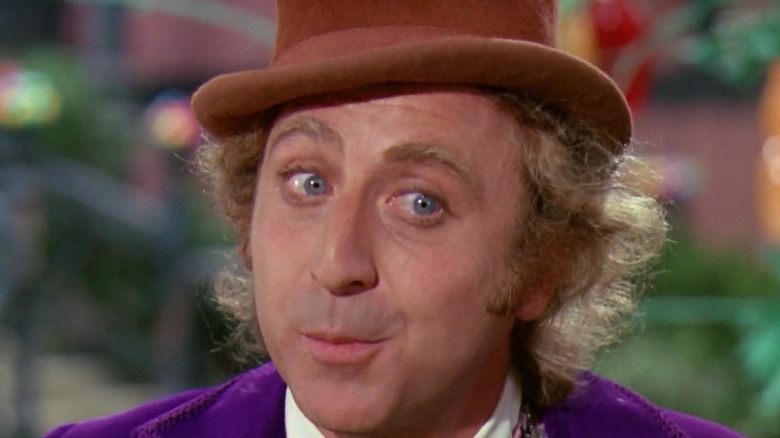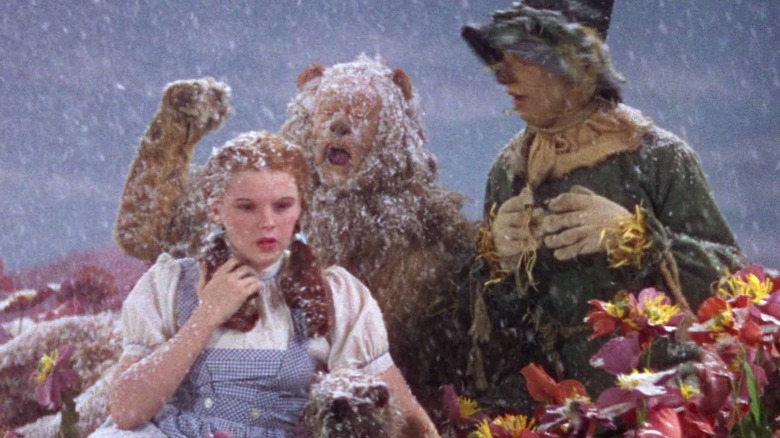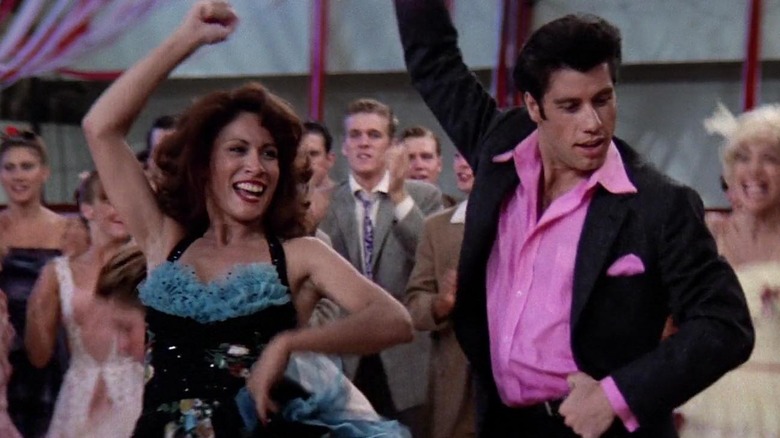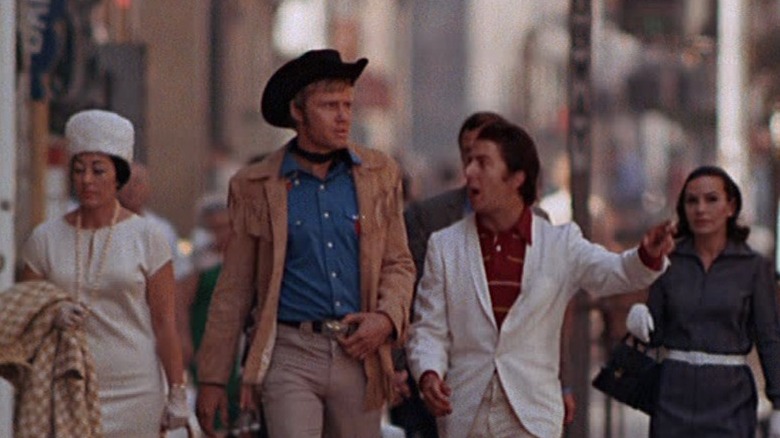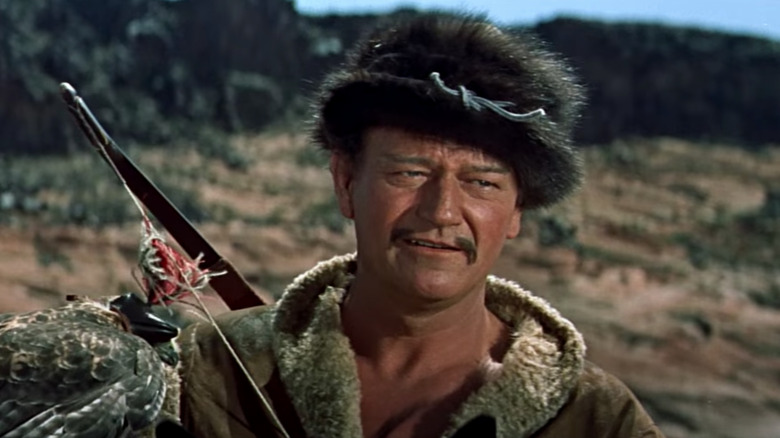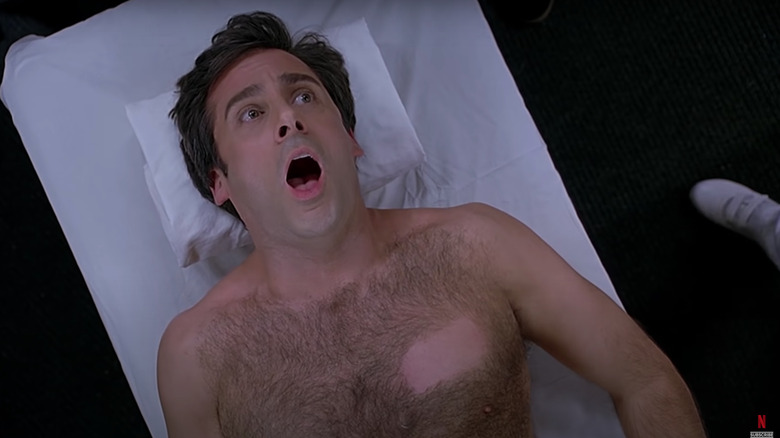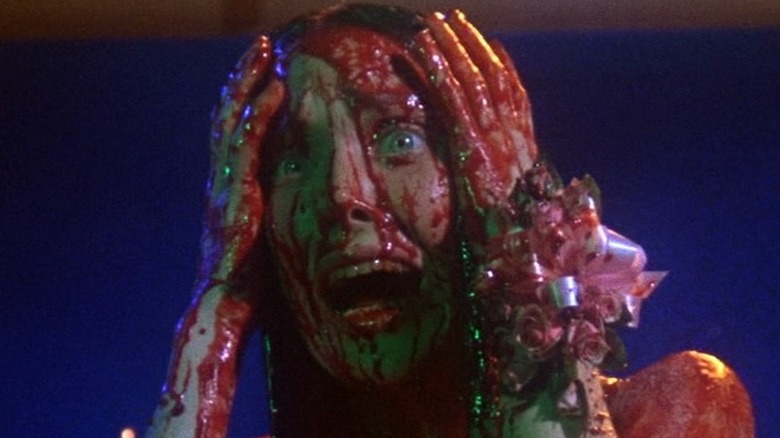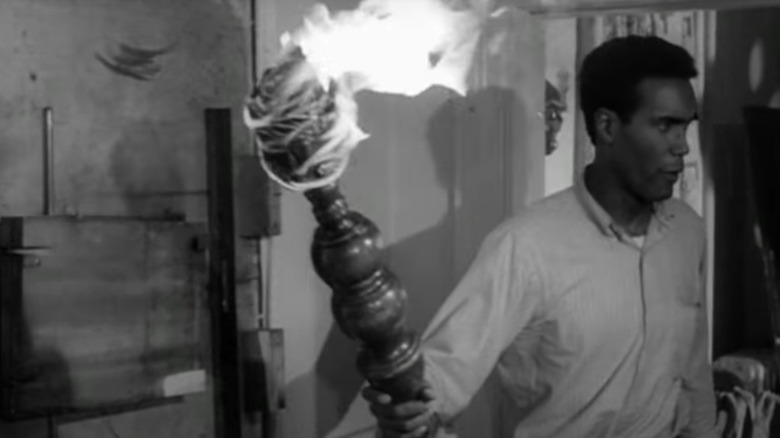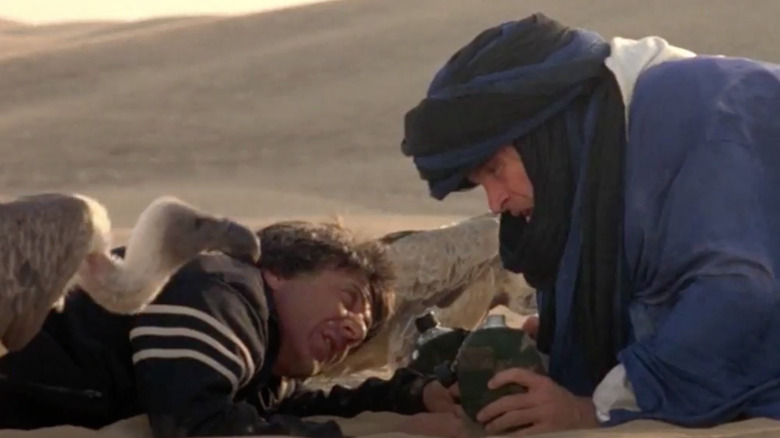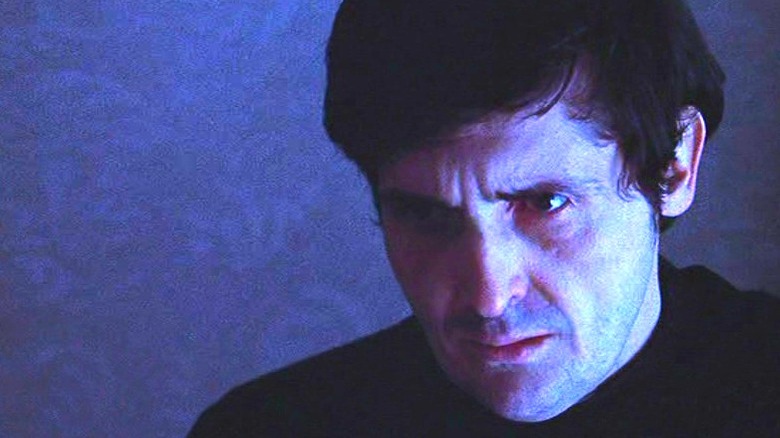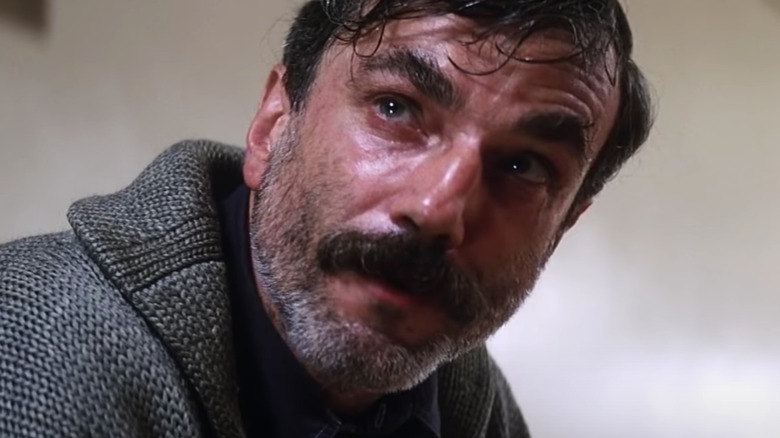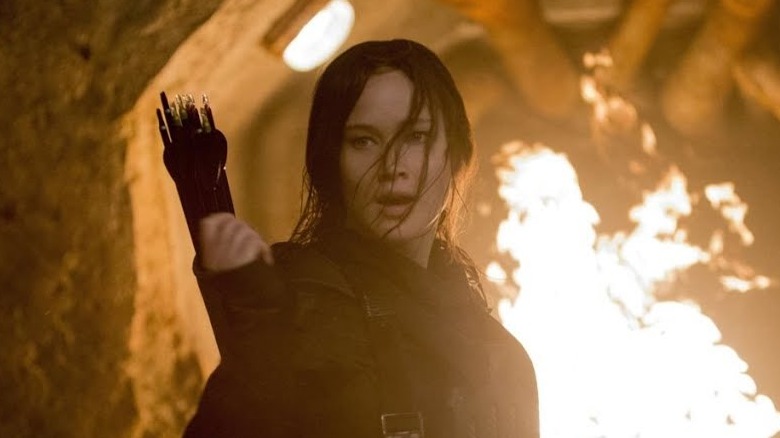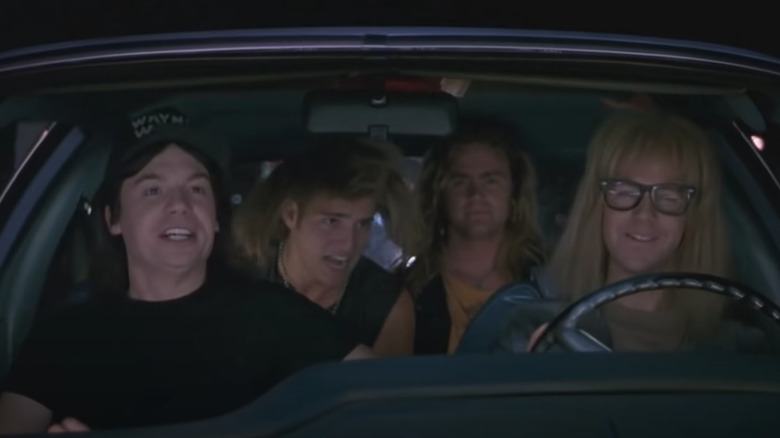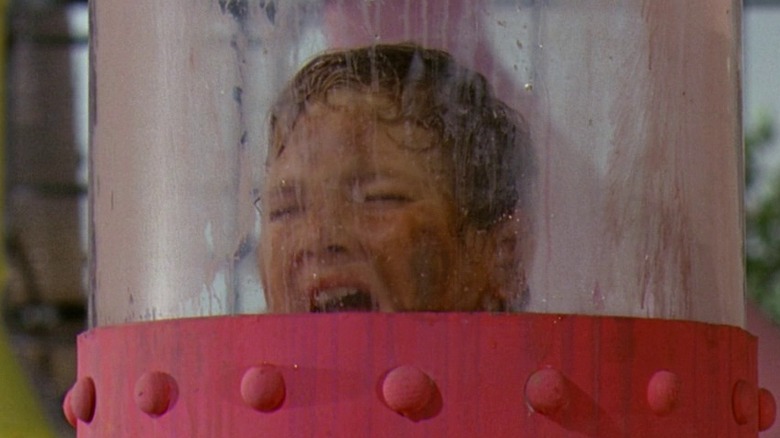Movie Scenes More Dangerous Than You Thought
Since its inception in the early 1900s, film has always been a space of potential danger and risk. The productions of old Hollywood didn't have the benefit of CGI, relying instead on sometimes unbelievable practical and special effects. So, when daredevils like Buster Keaton — the original Hollywood stuntman — needed a house to fall down around him, he actually had a house fall around him.
Not surprisingly, safety standards began to be implemented to protect folks working in film. Richard Nixon created the Occupational Safety Hazard Administration (OSHA) in 1970, which oversees the regulations of workplace safety in a variety of industries. Even though things have changed on productions since the days of classic Hollywood — we're not so sure directors can just flood the set with 600,000 gallons of water anymore — there are still dangers with filming, whether it's a stunt-filled action film or not.
In fact, it's often the films with seemingly the least amount of risk that pose the greatest danger to the actors. From beloved kids' movies to iconic '90s comedies, these are the surprising scenes that were actually dangerous to film. We'll never look at Willy Wonka's chocolate river the same way again.
The dangerous world of "Oz"
Kids and adults alike have loved "The Wizard of Oz" since its release in 1939, but beyond the bright technicolor world was a land of danger, accidents and poison. The production of "The Wizard of Oz" has become as legendary as the film itself due to its many unfortunate mishaps. The Wicked Witch of the West was accidentally set on fire when a trap door malfunctioned during a scene; the Tin Man got poisoned by his aluminum heavy makeup; even Terry, the dog playing Toto, wasn't exempt as one of the Winkie Guards accidentally stepped on her paw and broke it.
But surprisingly, one of the most dangerous moments of all was the poppy field scene. The Cowardly Lion, Tin Man, and Scarecrow stand above Dorothy, who lies unconscious among the poppies as snow gently falls around them. It turns out, things weren't so gentle — the fake snow was made of asbestos, a toxic carcinogen. The dangers of asbestos were known by the early 1900s, but that didn't stop producers from dousing Judy Garland and her co-stars with it.
A summer lovin' heat stroke
In spite of its name, "Grease" didn't run quite as smoothly as producers had hoped. The fun car racing scene called for John Travolta and Danny Stewart to splash through water that was stagnant and filled with bacteria. Jeff Conaway slipped and fell while doing a take of "Grease Lightning," leading to lifelong back pain and an addiction to opioids.
Ultimately, it was the prom scene, however, that proved most dangerous to film. On screen, viewers can enjoy a vibrant scene of bright colors, a dance off, and even John Travolta doing a split — but off screen, things weren't quite so fun. The Los Angeles gymnasium where the dance was filmed didn't have any windows or air conditioning, and doors were closed to control lighting. The location got so hot — a cool and casual 116 degrees — that several members of the cast had to be helped off set due to heat-related illnesses.
"Midnight Cowboy" takes to the streets
While the standard for filming on location in the middle of a city is to close down the street, that isn't always available when you're working on a limited budget. Such was the case for John Schlesinger, director of the Academy-Award-winning classic, "Midnight Cowboy." In the film, Jon Voight plays a sex worker who strikes up an unlikely friendship with Dustin Hoffman as a con man named Ratso Rizzo.
The most famous scene of the film, perhaps, was an accidental one that almost injured Dustin Hoffman. Since production didn't have the money to shut down the streets, they filmed Voight and Hoffman walking and talking in the middle of real New York City traffic. As they're exchanging dialogue, a cab driver tried to run through a red light, nearly hitting Hoffman. This lead to his real outburst of "Hey, I'm walkin' here!" The line turned out to become a classic moment in film dialogue — as well as immediate shorthand for the New York attitude.
The radioactive risk of "The Conquerer"
"The Conqueror," a 1956 John Wayne film produced by Howard Hughes, may be one of the most surprisingly dangerous films in history, although you wouldn't know it to see it. In the early years of the Cold War, the US created the Nevada Test Site in 1951 to test its nuclear weapons. Due to the winds, the brunt of the nuclear fallout was felt in St. George, Utah.
When producers of "The Conqueror" decided to film in St. George, they did so with the (false) assurance of the federal government that the nuclear test site posed no hazard to public health. Ultimately, every scene of the film that was shot in St. George proved to be incredibly dangerous.
By 1963, "The Conqueror" director, Dick Powell, had died of cancer and by 1980, 91 people from the production (41 percent) had developed cancer. Some say that John Wayne got cancer from this production (he died from it in 1979), although The Duke believed it was from his six-pack-a-day cigarette habit. Howard Hughes felt so guilty about filming at the radioactive site that he bought every print of the film and kept it out of circulation for decades, until Universal Pictures purchased it from his estate in 1979.
The world's worst chest waxing in "The 40-Year-Old Virgin"
For "The 40-Year-Old Virgin," Steve Carell decided to go full Method. Not only did he write the chest waxing scene for himself, but he also decided to get his chest waxed for real. While normally this isn't so dangerous — people get waxed all the time, after all — the stakes were unknowingly raised with the hiring of Miki Mia, who lied to the casting directors about her waxing proficiency.
Turns out, Mia had only waxed her boyfriend's back once before (how successfully, we'll never know) and didn't have any experience beyond that. So, while Carell perhaps anticipated some level of pain, what he didn't expect was nearly getting his nipples ripped off as Mia didn't take the important step of putting Vaseline around that area. The scene proved so painstaking to film that Romany Malco had to leave while Carell gritted his teeth and followed through with the process. But director Judd Apatow loves to keep things as real as possible, and one person's pain is another's laughter (what would comedy be without schadenfreude?), so we have Miki Mia to thank for one of the most hilarious scenes ever filmed.
Telekinesis goes awry with "Carrie"
Brian De Palma's "Carrie" continues to terrify viewers today, with its Stephen King-conceived tale of a bullied young woman pushed to her breaking point. The shoot was intense as Sissy Spacek was so committed to staying in character that she isolated herself from her cast mates, slept in her bloody dress and even insisted on being buried alive so she could push her own hand out of the grave (rather than use a stunt double).
In spite of all this, it was the climactic prom scene when Carrie goes after her tormentors that proved to be most dangerous. With scenes like this, filmmakers have to plan carefully to avoid mishaps but still, things can happen, especially when a fireman refuses to operate the firehose because it's too strong and a stuntman does it instead.
PJ Soles, who plays the red-capped bully, Norma, discovered this danger first hand when she got sprayed in the ear with a fire hose. The power was so intense that she suffered from a ruptured ear drum for six months and the painful moment is even included in the final cut of the film, as you see her writhing in real pain.
"Night of the Living Dead" takes extreme measures
"Night of the Living Dead" is one of the most influential horror films of all time, primarily because of its realism. Audiences watching the scene of Duane Jones (as Ben) and the others fighting off zombies with Molotov cocktails may be amazed by how believable it looks. As it turns out, it's even more realistic than we think, as the actors threw actual Molotov cocktails into the crowd of people playing zombies.
John Russo, who wrote the film with director George A. Romero, noted that it wouldn't be believable to have so many Molotov cocktails thrown and no one catch fire. So naturally, he volunteered himself as tribute. He wore no safety padding, other than a few layers of regular clothing. As he recalls it, "when I felt myself getting hot, I'd fall to the ground, and people were ready with blankets to smother the flames." Zombie actor Bill Hinzman also offered to be set on fire by Jones' torch but luckily, both men walked away without injury.
"Ishtar" offers up Dustin Hoffman to the vultures
Elaine May's "Ishtar" went down in film history as one of Hollywood's greatest bombs, and trouble plagued it from production into release. The 1987 adventure comedy stars Warren Beatty, Dustin Hoffman and Isabel Adjani, and was filmed on location in Morocco. What could go wrong with a handful of warring egos, intense climate conditions, and high political tensions in North Africa? Answer: a lot.
The film became infamous for its extravagant over-spending and May's high number of takes, which led to a fatal heart attack of a cobra that was supposed to be in the film. Perhaps the most dangerous scene was the one where Hoffman lies in the desert, surrounded by vultures. In order to get the large, frightening birds to fly down around him, production placed raw pieces of meat on Hoffman's body, just out of frame. "Are these vultures going to know where the raw meat ends and I start?" Hoffman asked. Unfortunately for him, he had to do 50 takes to find out.
Dangerous directing tactics on "The Exorcist"
"The Exorcist" has become as famous for its terrifying set as for its horror on screen, to the point that people working on the film believed it was cursed. Ellen Burstyn suffered a permanent back injury while being yanked by a harness, the entire set burned down due to a rogue pigeon, several cast members died while the film was in production, and a priest had to be brought in to bless the set.
Such a physically demanding film, understandably, has risks but one of the more dangerous moments came as a result of the director's scare tactics. In order to elicit the most authentic reactions on screen, William Friedkin would randomly shoot guns on set. Jason Miller, who played Father Karras, got into an altercation with Friedkin after he fired a gun next to Miller's ear to get a surprise reaction. Miller noted that as an actor, he doesn't exactly need a gun to be surprised or startled. Friedkin never denied the claims of his gun-wielding on set; in fact, he dismissed them because after all, he was only firing blanks.
There will be bowling balls thrown at your head
Daniel Day Lewis is arguably one of the most Method actors of all time. Whether it's spending an entire shoot in a wheelchair for "My Left Foot," learning to track and skin animals for "Last of the Mohicans," or staying in a solitary prison cell for two nights for "In the Name of the Father," the man commits to a role.
It's no surprise, then, that he got fully into character to play one of his most iconic roles — violent, angry oil man Daniel Plainview in Paul Thomas Anderson's "There Will Be Blood." Many remember the iconic moment of Day Lewis screaming "I drink your milkshake!" at Paul Dano, but what viewers may not realize is that this climactic scene was actually quite dangerous to film. Ever the realist, Day Lewis insisted on throwing actual bowling balls at Paul Dano, who just barely got out of the way. The realism certainly added to the moment, helping create an iconic film moment.
"The Hunger Games: Mockingjay Part II" causes a stink
An action series like "The Hunger Games" requires a lot of safety planning due to all the stunts, but the most dangerous (and unpleasant) scene to film may surprise you. Jennifer Lawrence made headlines after kicking Josh Hutcherson in the head while the two were goofing around, and Liam Hemsworth hurt his ankle while filming "Mockingjay Part II," but it was the sewer scene that really put people in danger.
In spite of having a sewer built on a soundstage, director Francis Lawrence decided to do the scene on location in a real sewer. The water was heated, the ceilings were low (which wasn't ideal for the 6'3” Liam Hemsworth) and costumes got water-logged, adding at least 20 extra pounds on top of the actors. Plus, being in an actual sewer isn't exactly sanitary, which led to a quite miserable three-week shoot for everyone. But in the end, they got the shot — and in the unique realm of Hollywood, sometimes that need transcends all else.
"Wayne's World" epic head-banging
It's not just action films that can prove dangerous for actors. The physical nature of some comedies can also create opportunities galore for people to get injured, which was the case for Mike Myers and Dana Carvey in "Wayne's World."
Who can hear Queen's "Bohemian Rhapsody" without thinking of the iconic head-banging scene from the first "Wayne's World" movie? Myers fought to have that song included in the scene, instead of the original pick of Guns n' Roses, and it paid off by becoming one of the all-time iconic movie music scenes.
According to Myers, though, it wasn't all fun and games. The guys in The Mirthmobile (a light blue 1976 AMC Pacer with flames painted on the sides, in case you're wondering) got very into the moment, and director Penelope Spheeris needed many, many takes to get proper coverage for all the various angles you see in the scene. As a result, that scene took almost an entire night to shoot, leading to some serious neck pain. As Dana Carvey told Rolling Stone in 2015, he was 36 at the time and needed more than a few Advil to get through the night.
Film fans will be forever grateful for his commitment, however, as the '90s wouldn't have been the same without this classic moment.
Willy Wonka's chocolate river of coffee and curdled cream
Since its 1971 release, "Willy Wonka and the Chocolate Factory" has inspired the dreams of countless children and adults alike. Willy Wonka's iconic chocolate river in particular stands out as a place of fun and fantasy. But filming in this candy wonderland wasn't quite as wondrous as viewers might think.
According to Michael Bollner, who played Augustus Gloop (the greedy kid who plunges into the chocolate river), this dream was a bit of a nightmare. It was "stinky water," made of 150,000 gallons of water, cream, chocolate ... and leftover coffee dumped by folks on set. The stench of the river only got worse over time, as the cream spoiled during the course of the shoot.
Bollner had to do multiple takes, spending the day soaked in his smelly clothes. Each take required him to go back up into the tube, where he was stuck with water up to his mouth. The filming of this scene was so problematic that Peter Ostrum, who played Charlie Bucket, noted that OSHA likely had not approved such working conditions.
